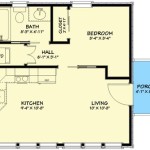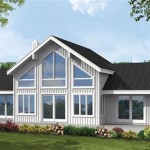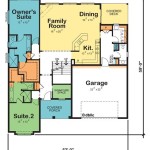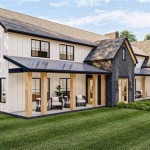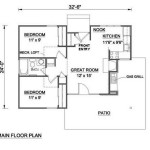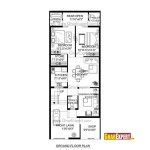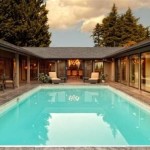```html
Home Plans For View Lots: Maximizing Scenery and Structure
Designing a home for a view lot presents unique opportunities and challenges. Unlike building on flat, featureless land, a view lot demands a design that not only accommodates the topography but also strategically frames and enhances the natural landscape. Careful consideration must be given to factors such as orientation, window placement, floor plan layout, and structural integrity to create a residence that seamlessly integrates with its surroundings while providing optimal comfort and aesthetic appeal.
The term "view lot" encompasses a wide range of terrains, including sloping hillsides, elevated plateaus, and waterfront properties. Each type of view lot requires a tailored architectural approach to fully capitalize on its potential. The primary goal is to design a home that captures the most breathtaking vistas from various points within the dwelling, while also ensuring privacy and protection from the elements. This often involves a balance between maximizing glass surfaces and incorporating solid walls to maintain energy efficiency and structural stability.
Successful home plans for view lots prioritize the living spaces that benefit most from scenic views. Typically, these include the great room, kitchen, dining area, and master suite. Strategic placement of these rooms will allow homeowners to appreciate the surrounding landscape throughout the day. Furthermore, the design should consider the path of the sun to minimize glare and optimize natural light, especially during sunrise and sunset.
Key Considerations for View Lot Home Plans: Orientation and Elevation
The orientation of the home on the view lot is paramount. This involves determining the optimal direction the house should face to maximize views while minimizing exposure to harsh weather conditions. This often involves a detailed analysis of the site's topography, including the direction of prevailing winds, the angle of the sun throughout the year, and the location of existing vegetation.
For example, a home on a south-facing slope may benefit from large windows that capture sunlight during the winter months, while strategically placed overhangs or awnings can provide shade during the summer. Conversely, a north-facing slope may require a different approach, such as larger windows to maximize natural light and careful insulation to minimize heat loss.
Elevation is another crucial factor. Multi-story homes often provide the best vantage points, but they also require careful engineering to ensure stability on uneven terrain. Split-level designs can be an effective way to adapt to sloping lots while maintaining visual interest. Furthermore, the elevation of the home should be carefully considered in relation to surrounding properties to preserve the view for both the homeowner and their neighbors.
Retaining walls and terracing can also be employed to create level building pads on sloping lots. These techniques not only provide a stable foundation for the home but also enhance the landscape by creating usable outdoor spaces, such as patios, gardens, and decks.
Floor Plan Design for Optimal View Integration
The floor plan of a view lot home should be carefully designed to ensure that the most important living spaces have unobstructed views. Open-concept designs are often favored, as they allow for a seamless flow between the kitchen, dining area, and living room, all while maximizing exposure to the surrounding landscape. Large windows, sliding glass doors, and balconies can further enhance the connection between the interior and exterior spaces.
The master suite is another area that should be prioritized in view lot home plans. A spacious master bedroom with large windows and a private balcony can provide a tranquil retreat with stunning views. The master bathroom can also be designed to take advantage of the scenery, with a soaking tub or shower strategically positioned to offer panoramic vistas.
The placement of secondary bedrooms and other less-used spaces should also be considered. While these rooms may not require the same level of view integration as the primary living areas, they should still be designed to capture natural light and provide a sense of connection to the outdoors. The use of skylights, clerestory windows, and smaller windows with carefully framed views can add visual interest and enhance the overall appeal of the home.
Accessibility is also an important consideration, particularly for homeowners with mobility issues. Ramps, elevators, and wider doorways can be incorporated into the design to ensure that the home is accessible to everyone. Furthermore, the layout should be designed to minimize the need for stairs, whenever possible.
Structural Considerations and Material Selection
Building on a view lot, particularly one with sloping terrain, often requires specialized structural engineering. Soil testing is essential to determine the stability of the ground and to identify any potential risks, such as landslides or erosion. The foundation must be carefully designed to withstand the forces of gravity and to prevent settling or shifting of the structure.
Retaining walls, as previously mentioned, can be used to stabilize the soil and to create level building pads. These walls must be properly engineered to withstand the pressure of the earth and to prevent water damage. Drainage systems should also be incorporated to ensure that water is properly diverted away from the foundation.
Material selection is another crucial aspect of view lot home plans. Durable, weather-resistant materials are essential to withstand the elements and to minimize maintenance over time. Natural materials, such as stone, wood, and concrete, can blend seamlessly with the surrounding landscape and create a sense of harmony. The choice of materials can also impact the energy efficiency of the home. For example, using insulated concrete forms (ICF) can provide superior insulation and reduce energy consumption.
The roof design is also important from both an aesthetic and functional standpoint. A low-sloping roof can minimize the visual impact of the home on the landscape, while also providing space for solar panels. A green roof, which is covered with vegetation, can further enhance the environmental sustainability of the home and provide additional insulation.
Windows are a critical element of view lot homes, and careful consideration must be given to their size, placement, and type. Large windows can maximize views, but they can also increase heat loss or gain. Low-E glass can help to mitigate this effect by reducing the amount of heat that passes through the glass. Window orientation is also important, as south-facing windows can capture sunlight during the winter months, while east- and west-facing windows may require shading to prevent overheating during the summer.
In summary, designing a home for a view lot requires a comprehensive approach that considers both the aesthetic and functional aspects of the structure. By carefully considering orientation, elevation, floor plan design, structural considerations, and material selection, it is possible to create a residence that seamlessly integrates with its surroundings while providing optimal comfort and enjoyment for its inhabitants. A collaborative effort between the homeowner, architect, and builder is essential to ensure that the vision for the home is realized in a way that is both beautiful and sustainable.
Ultimately, the goal of any view lot home plan is to create a space that allows residents to fully appreciate the beauty of their surroundings and to connect with nature in a meaningful way. This requires a thoughtful and intentional design process that prioritizes both the views and the functionality of the home.
```
Modern House Plan Sloping Lot Contemporary Style 5590 Vista

House Plans With Windows For Great Views
House Plans For View Lots From Visbeen Architects Builder

View Home Sloping Lot Multi Level House Plan 3d 360 Basement Plans Custom
House Plans For View Lots From Visbeen Architects Builder

Home Plans With Lots Of Windows For Great Views

Craftsman Style House Plan 3 Beds 2 Baths 1275 Sq Ft 48 586 Builderhouseplans Com

Hillside House Plan Modern Daylight Home Design With Basement

Plan 23286jd 4 Bed Craftsman House With 3 Car Angled Garage Plans Rustic Lake
House Plans For View Lots From Visbeen Architects Builder

